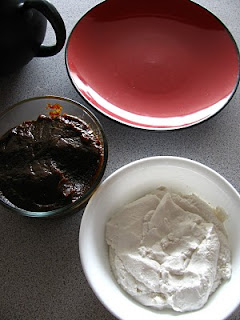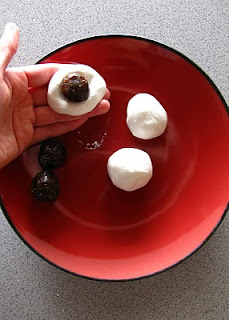Wikipedia has an entry about Tang-Yuan that seems to pretty much line up with what I remember about them.
Last year I made some of these with mochi flour and a rather poor approximation of mung bean filling. This year, I got a bug in my ear and decided to go from scratch. And I managed to remember that when I was very small and was eating them for probably the first or second time, the ones with plum filling were my favorite. The ingredients are simple, the procedure is not complicated, but it is time consuming and labor-intensive in parts. Do not attempt the filling recipe unless you are willing to literally stir constantly for about 40 minutes. Your arm will get tired.
Here's what you need:
2 or 3 cups sushi rice, in a large pot big enough to fit that plus about 5 cups of water.
a blender, a large colander and a piece of muslin big enough to line it with.
3/4 lb of prunes
2/3 cup cooking oil or shortening. Saturated fats will make the finished produce easier to work with.Lard is traditional, dad used duck fat when he had it. Chicken, maybe not.
possibly a half cup of sugar, but I didn't this time, I wanted it to be a little tart.
a very heavy 2 qt cooking pot, and NOT a non-stick one.
This recipe will make enough for a whole party of squeamish people, or for a small number of afficionadoes. They are even more weird and ethnic than mochi.
Leave the rice in the water for up to a week, and at least 3 days. Unless you want to risk having it ferment, stow it in the fridge. The rice grains will absorb water to the point where they start to disintegrate. Pinch one in your fingers and you'll see. It'll crush into a coarse mush. Then line your colander with the muslin, and put the rice through the blender, using only as much water as needed to keep it liquid enough for the blender to cope with it. This will take a while. Get it as finely ground as possible, and pour it into the muslin lined colander. Tie up the cloth and let the liquid drain out (this is likely to take at least 24 hours, so put it back in the fridge), and the mass of rice paste is your dough. You should freeze it if you aren't going to use it within a couple days. I found that after draining, freezing and thawing once, it was still coarser than I wanted, so I put a glob of it back in the mini-process and ground it again, with very good results. I suspect that the freezing helps break down the grains.
For the filling, put the prunes in the heavy pan with enough water to cover them, and bring them to a boil. After about 8 or 10 minutes, they should be tender enough to put in the blender, again using as little water as possible. Return the pureed prunes to the pan and add the oil and the sugar if you want it. From now on, be prepared to stir. With the heat at medium, use a wooden spoon to methodically scrape the bottom of the pot. The correct temperature for cooking will make the puree sizzle gently but quickly as you expose the bottom of the pan when stirring. You are going to cook all the water back out of the prunes which you just put in. After about half an hour of stirring, the paste will begin to form a coherent mass, and some of the oil will begin to sweat back out of it. It's done when it is very dark and has a consistency about halfway between Jif and Play-Doh. Turn off the heat and keep stirring until the paste stops sizzling against the pan, then refrigerate it in tupperware until you want to use it.
You know, lots of fruits can be treated this way. Dad used pineapple one year, which was good, and once, there was a batch made out of dried chinese red plums. That didn't go over so well, it was full of tough, splintery fibers. It tasted good, but the texture was decidedly sinister. Very pokey. Good lord, that must have been in like, 1979 or something. Don't feed things like that to your kids, they'll never forget. Anyhoo, the thing is, after all that cooking, anything you use will have a tendency to taste similar. It's the caramelization.
What to do with it:
Take the rice dough, pinch off pieces about 2 tablespoon sized, and roll them onto balls. If the dough was drained long enough to make it too dry, just add a little water back into it. Make little balls out of the filling, about 1 teaspoon sized. Hold one of the dough balls in your palm and poke a hole in it about down to the middle, and push one of the filling bits into the hole. Gently roll the dough in your palms to re-form it into a solid ball with no filling showing. The whole business should end up about the size of a ping-pong ball. Continue until you have as many as you want.

Bring a large pot of water to a boil and drop the tang-yuan into it. Stir them once so they don't stick to the bottom. Wait for the water to boil again. Once the water boils, turn it down to a simmer. When the tang-yuan are done, they will float to the surface. As the rice starches expand, they become more buoyant. The side that is immersed in the hot water will eventually become so much less dense than the top that they will flip themselves over if you poke them gently. Don't cook them any longer than that, the dough will just disintegrate.
Traditionally, these are served in a generous amount of the cooking water. I think that just makes them watery-tasting, so I usually don't do that. However, I have to admit that cooking them from scratch makes the cooking water actually pretty appealing. The freshness of the rice flour is orders of magnitude more delicious than frozen store-bought, and the texture is both firm and tender. You would think something made out of just rice would be boring, but that doesn't have to be so. Rice should taste like rice, and things made out of it should be yummy.
Lastly, I used olive oil in my filling. It's ok, but I don't really recommend it. The oil oxidizes or something in the cooking, and even if you use the most boring kind, the taste becomes more pronounced at the end. Like I said, ok, but definitely not traditional. Use peanut or canola or corn oil if you can't bear to use lard.











No comments:
Post a Comment